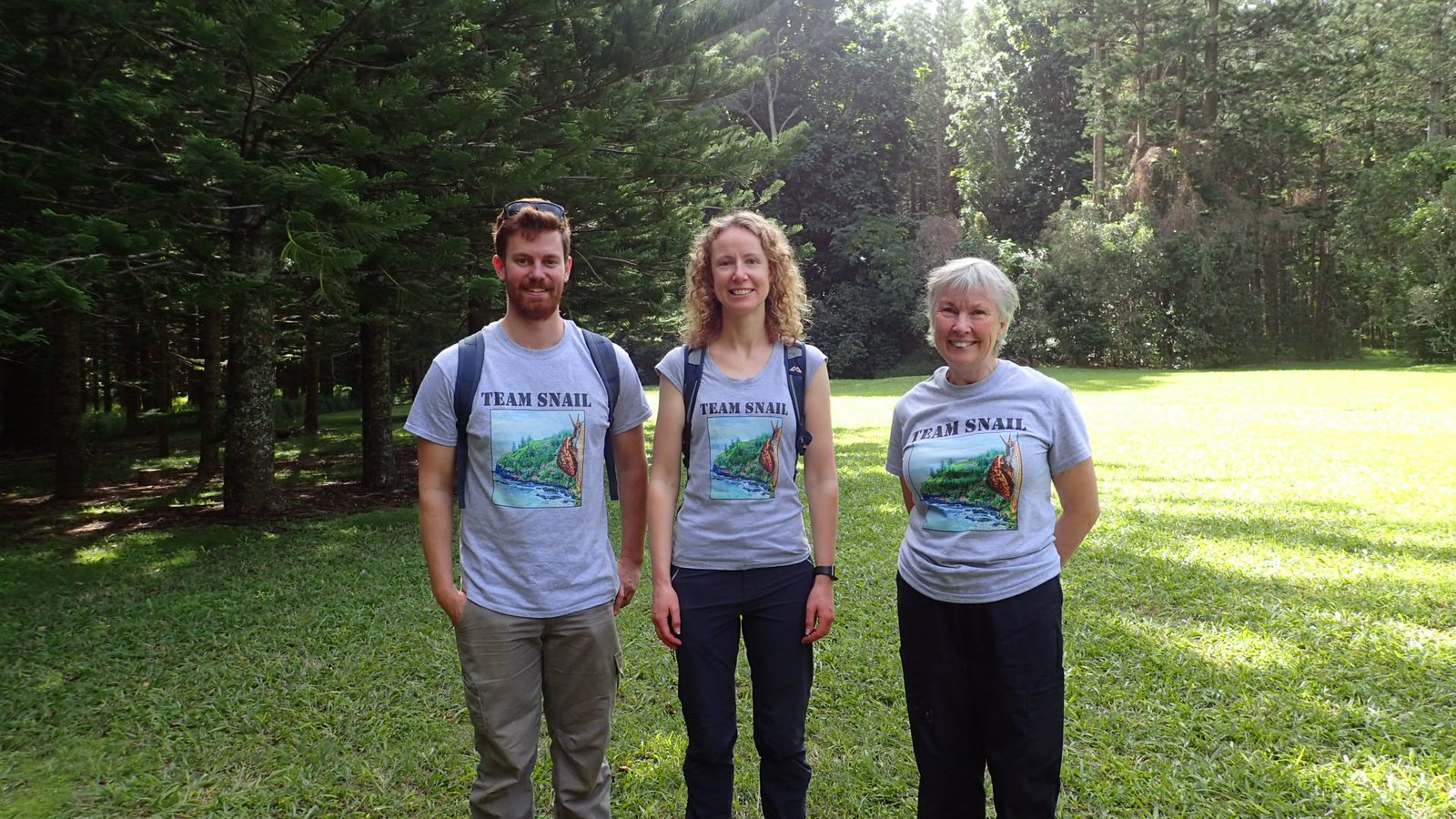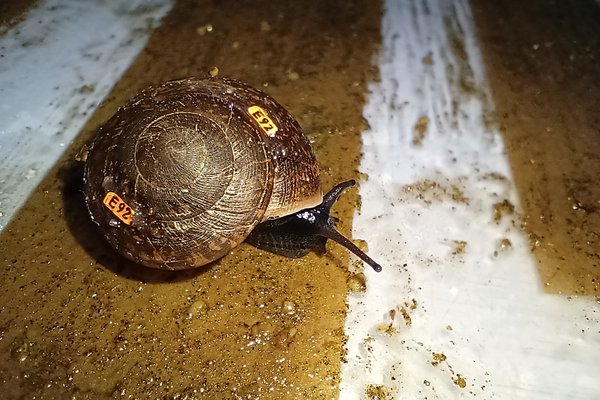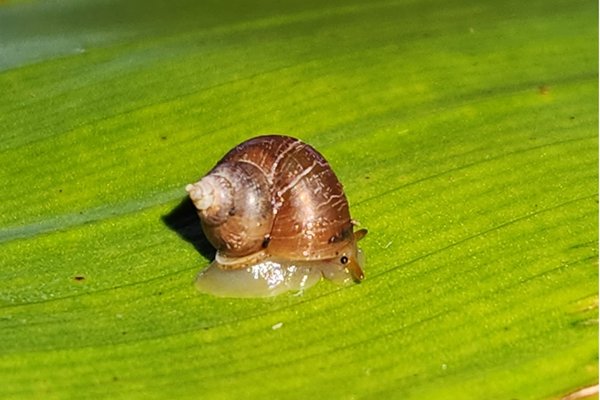The science behind the stamps: Land snail research on Norfolk Island
Australia Post has just released a new stamp issue featuring two of Norfolk Island’s beautiful endemic land snails – species that are currently the focus of taxonomic and conservation work by AMRI scientists.
Land snail diversity is often extraordinarily high on oceanic islands, where isolation from the mainland and the absence of predators can result in large radiations of endemic species. This is the case for Norfolk Island, where many unique forms have evolved over the mere three million years since the island’s formation. For this reason, the endemic land snails of Norfolk Island are currently the focus of taxonomic and conservation work that I am carrying out in conjunction with Dr Frank Köhler. In May 2021, I travelled to Norfolk Island with Dr Mandy Reid (AMRI) and Andrew Daly (Taronga Zoo) to continue our surveys of the land snail fauna, and to collect specimens for a captive breeding program based at Taronga Zoo. And two of the species that we are studying have been celebrated in a recent stamp release!

© Used with permission.

© Used with permission.

© Used with permission.
Despite its small size and recent formation, Norfolk Island is one of Australia’s richest hotspots of land snail diversity, with 70 described species. When our taxonomic revision of these snails began in 2019, the majority of these species were known only from their shells, with no existing live images and little to no information known about their taxonomy, ecology, distribution, life history or conservation status. Our surveys have led us to realise that some species are at high risk of extinction. This has led to the development of a captive breeding program for two Critically Endangered species in conjunction with Taronga Zoo, Parks Australia and the Norfolk Island Regional Council. In addition, studying these species gives a fascinating insight into the evolutionary processes that led to this extraordinary biodiversity.

Image of Andrew Daly, Isabel Hyman and Mandy Reid on Norfolk Island.
Image: Isabel Hyman© Isabel Hyman
On Norfolk Island, the evolutionary radiation of land snails is very young, since the island was only formed (by volcanic activity) between 2.3 and 3 million years ago. Evolution is, of course, an ongoing process, and so we would expect different groups of snails to be at different stages of speciation. Some Norfolk Island species appear to have only recently diverged – and often, they are very similar to one another in appearance. In other cases, even if there are many visible differences present, our anatomical and genetic work show that only a single species is present. It is possible that we are seeing very early signs of divergence, and given time, the species may split into two.
The two snails featured in the new Australia Post stamps, Duritropis albocarinata and Greenwoodoconcha nux, both belong in the second category. There is considerable diversity present in the shell, sufficient in both cases for early scientists to divide them into two species. However, a more detailed investigation of comparative anatomy and genetic divergence shows just a single species present in each case.
Duritropis albocarinata is a small snail with a conical shell. In some specimens the shell is elongate and smooth, while in others it is shorter and broader with a sculpture of wavy ribs, and there is also considerable variation in shell colour and banding. However, careful examination shows that there appears to be a continuum between the two forms, and we believe (and hope soon to confirm) that just a single species is present.
Greenwoodoconcha nux is a medium-sized snail with a beautiful glossy shell, chocolate to reddish brown with a broad white peripheral band. However, some specimens have a golden-brown, uniform shell that is missing the peripheral band. This form was originally described as a separate species, but we have found that there are no consistent morphological or genetic differences between them and so we now consider them to be a single species.
Other remarkable forms present on the island include a species with a heavily ribbed shell sculptured with spines, and another species that sticks mud onto its shell for camouflage. The broad morphological diversity of the land snail fauna reflects the rapid diversification that can occur shortly after islands are first colonised. The sheer beauty and diversity of land snails on Norfolk Island is fascinating to explore, and we are delighted that it is being celebrated and shared with the world through the medium of stamps!
Dr Isabel Hyman, Scientific Officer, Malacology, Australian Museum Research Institute.
Acknowledgements:
Documenting the Land Snails of Lord Howe Island and Norfolk Island was funded by the Australian Biological Resources Study, the Graeme Wood Foundation and the Office of Environment and Heritage.
Saving Threatened Snails on Norfolk Island was funded by the Australian Museum Foundation and National Geographic, and is carried out in conjunction with Taronga Zoo, Parks Australia and the Norfolk Island Regional Council.
More information:
- Philatelic Team. Preserving the land snails of Norfolk Island. 2021. Australia Post, https://australiapostcollectables.com.au/articles/preserving-the-land-snails-of-norfolk-island
- Hyman, I. Raised from the dead: Species assumed extinct rediscovered on Norfolk Island. 2020. Australian Museum blog. https://australian.museum/blog/amri-news/species-assumed-extinct-rediscovered-on-norfolk-island/
- Hyman, I. Rare snail species found alive on Norfolk Island after 130 years. 2020. Australian Museum blog. https://australian.museum/blog/amri-news/rare-snail-species-found-alive-on-norfolk-island-after-130-years/
- Hyman, I. How does a land snail become a threatened species? 2020. Australian Museum blog. https://australian.museum/blog/amri-news/how-does-a-land-snail-become-a-threatened-species-/























